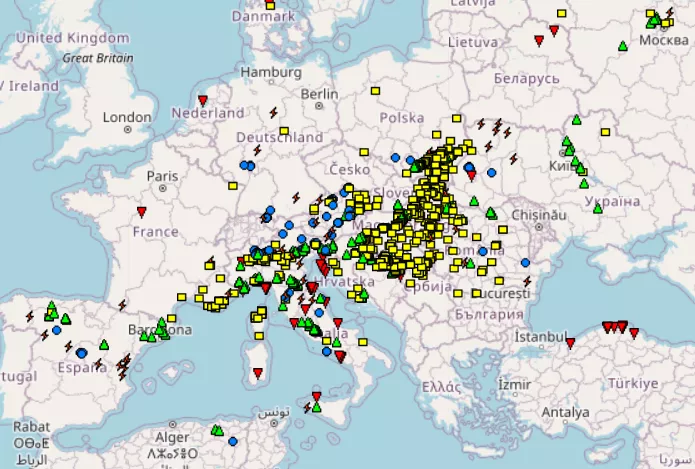
A severe wave of extreme weather hit Central and Southern Europe around 7.-10. July 2025, causing widespread damage including Italy, Slovenia, Croatia, and Austria. The series of storms brought hurricane-force winds, torrential rain, large hail, and localized tornadoes, resulting in impassable roads, uprooted trees, damaged roofs, and multiple injuries.
The storm front, originating from northern Italy, rapidly intensified over the Veneto and Friuli regions on July 8. Gusts of wind exceeding 100 km/h were recorded in several towns including Verona, San Giovanni Lupatoto, and Vicenza. The MeteoNetwork Pretemp reports confirmed wind speeds up to 104.8 km/h in San Giovanni Lupatoto, causing trees to fall on roads and vehicles. Verona reported similar wind intensity with widespread tree and branch damage.
Further east, severe wind events were reported in Slovenia and Croatia. Social media and trained observer reports documented heavy damage in Slovenian towns such as Ptuj, Maribor, and Murska Sobota. Impacts included damaged rooftops, cars crushed by falling branches, and widespread power outages. The Slovenian Environment Agency (ARSO) recorded wind gusts exceeding 90 km/h in multiple locations.
In Croatia, a confirmed tornado near Velika Gorica on July 8 caused structural damage and snapped trees along a narrow path. Meteorological radar and video evidence supported the classification of an IF1 tornado. Additional storm activity in Slavonia and Zagorje regions led to widespread agricultural losses and closed roads.
Austria was also affected as the storm system pushed northeast. The most significant damage was observed in southern regions such as Styria and Carinthia. Uprooted trees blocked major roads and disrupted rail traffic. In Graz and surrounding areas, fire departments responded to hundreds of calls for flooded basements and wind-related damage.
In many places, severe winds events were accompanied by hailstones up to 4 cm in diameter, particularly in northern Italy and eastern Slovenia.
These back-to-back events highlight the growing frequency and severity of convective storm outbreaks across Europe during the summer season. Meteorologists point to a potent combination of warm, moist air from the Mediterranean and upper-level troughs that acted as triggers for explosive storm development.
As recovery and cleanup efforts continue, authorities are urging citizens to remain cautious and heed severe weather warnings. The storms serve as a stark reminder of the destructive power of nature, even in regions not typically associated with such frequent extreme wind events.

Source: https://eswd.eu/cgi-bin/eswd.cgi


























